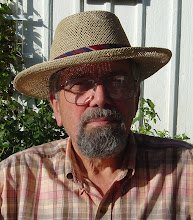A need for large washers was mentioned in the last posting. I wasn’t satisfied with the washers available to me at the hardware store, so chose to make them myself. I had a pair of ancient gate hinges made of strap mild steel of the right width. I was planning to use 5/16” threaded rod for the connections, and so I drilled spaced holes 3/8” diameter along the centre of the hinge strap. I countersunk these holes to facilitate easier entry of the connecting rods. I then hacksawed the strap into square washers. I believe the square shape provides better thrust distribution for this application. Furthermore, it was a simple matter with a straight bit to rout out recesses in the post halves to house this shape.

 The only way I know of to make precisely true
central cores down long sections is to make the post in two halves, routing or
dadoing a channel down the middle of the inside surface of each half. I did this, making a half inch diameter
central channel. I modified this channel
by hand carving to a hexagonal shape at the point where the collar nut would
lie, so that it could never turn in the wood. Behind (downstream) of the nut I
laid in a short section of dowel to stabilize the collar against longitudinal
movement. The photo shows all this
assembled, ready to be glued up. When gluing up I left a piece of threaded rod inserted into the collar nut so as to keep it perfectly aligned during the process. I oiled the rod in case of contact with the glue, and held the other end perfectly centred in the channel with a scrap of vinyl tubing.
The only way I know of to make precisely true
central cores down long sections is to make the post in two halves, routing or
dadoing a channel down the middle of the inside surface of each half. I did this, making a half inch diameter
central channel. I modified this channel
by hand carving to a hexagonal shape at the point where the collar nut would
lie, so that it could never turn in the wood. Behind (downstream) of the nut I
laid in a short section of dowel to stabilize the collar against longitudinal
movement. The photo shows all this
assembled, ready to be glued up. When gluing up I left a piece of threaded rod inserted into the collar nut so as to keep it perfectly aligned during the process. I oiled the rod in case of contact with the glue, and held the other end perfectly centred in the channel with a scrap of vinyl tubing.For specialised work of this kind I use a powdered resin glue, which is mixed with cold water into a thin syrup. This glue is extremely strong and waterproof: ‘marine grade’. It sands well and cleanly, so the line will be invisible at finish. Far better in my view than the poly-vinyl type of glue. As you look at the photos, you may be wondering (worrying?) about the pattern match as I lay up these pieces. It is obvious that there is a poor match in the side visible above. Wherever possible I ‘book-matched’ two pieces to form one of the legs. My original stock being 2x6 inches or 2x7, I was able to do this in most cases, which meant that I ended up with three good sides to the leg. Only two sides of the lower leg section are visible; the poorest side ends up on the inside. After planing, jointing, ripping the plank in two and final dressing, the resulting glued up posts ended up approximately 3¼” square. I took that down afterwards to a smidge over three inches square.




No comments:
Post a Comment